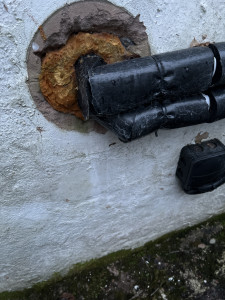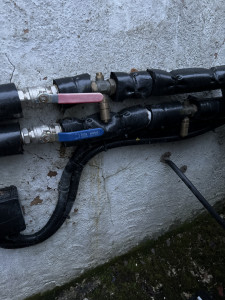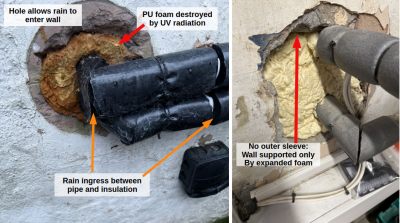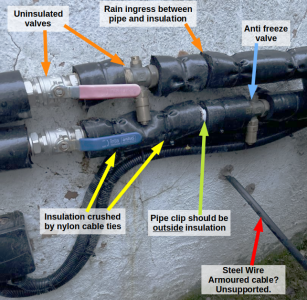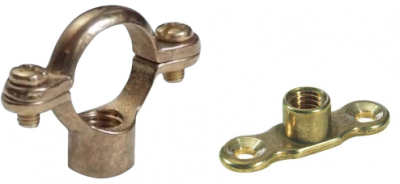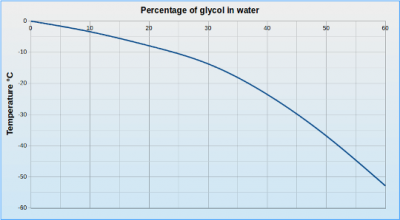The readings were taken on CH mode. The DHW is timed to come on during the night when my cheap rate kicks in.
@jgtukpd On my iPad, all I see is a duplication of some photos of the valves and insulation on external pipework. If this is the subject of your posting, then I think your pipework may well be compromised by the very tightly fixed plastic straps and by the open mitred joints. I expect @transparent will be along soon to explain more. Regards, Toodles.
Toodles, heats his home with cold draughts and cooks food with magnets.
Annotations added to your photos:
(external view on left)
external pipe run should be completely sealed against rain.
Should be in pipe diameter of at least 28mm.
The 17kW ASHP has 1¼-inch BSP pipe entry ports.
UV-resistant (solar) insulation wall thickness should be 19mm.
It should continue right through the wall, rather than stopping where expanding foam has been sprayed in.
Support pipe using Munsen rings fitted outside of the insulation.
The end of the insulation nearest to the external ASHP unit should be sealed using an acrylic polymer mastic,
and then covered with 3mm thick Armaflex tape.
The present arrangement allows ingress of water between the pipe and insulation.
This extracts the heat and discards it onto the ground. 😲
In the event of the external pipe-run freezing, the anti-freeze valves will open and discard all the water onto the ground.
The external unit is protected from damage, but the house will be left without heating or hot water.
Was this specified?
Was the use of glycol discussed?
Frost protection settings are discussed on Page-40 of the Installation Instructions.
Save energy... recycle electrons!
I will try to address these issues.
In the event of the external pipe-run freezing, the anti-freeze valves will open and discard all the water onto the ground.
Was this specified?
Was the use of glycol discussed?
I have no knowledge of this so no, not discussed with me...
Thanks.
@jgtukpd - There are a number of different issues in what I've seen from your photos.
I'm going to assume that what I write here will be shared with Grant and your Installer.
This Topic is 'evidence' in the event that a dispute proceeds and perhaps results in you taking action under the Consumer Rights Act (2015).
Let's see if we can avoid that!
1: The structural integrity of your house wall is compromised.
The material above the large hole is unsupported within the usual interpretation applied by a Building Control Surveyor.
I am a self-builder, with decades of experience across all 'trades'.
(Today I intend plastering an internal wall and fitting coving between it and the ceiling).
Whilst we could waste time delving into the clauses of Building Regulations Part-A (Structure),
I should emphasise that almost all tasks in the construction trades come down to common sense!
If a (large) hole is made in a wall through which pipes or cables are to be passed, then
- the wall above that hole needs supporting by material which can bear that weight (ie not the pipes or cables!)
- the hole should slope slightly downwards towards the outside; thus any rain/moisture is directed out of the property
- the external face of the hole should be finished with a weather-proof finish, no less impregnable than the surroundings (cement render in your case)
Sometimes I line a hole with an outer sleeve which is incompressible, such as a metal pipe.
Or I might take out sufficient brickwork or blocks to fit a cast lintel, which forms the top of the hole.
For a double-skin/cavity wall, whatever lines that hole must avoid allowing heat out, or rain in.
Does your wall have a cavity?
What is the wall made of?
2: We need to know the size of the pipes which pass through that wall, and their composition (copper, polythene?).
When dealing with the low temperatures available from a heat-pump, there is a finite amount of energy which can be transferred along the pipe!
There's no point insulting pipes which aren't of adequate size in the first place.
3: You need to consider what will happen when some aspect of your system fails.
The one we're facing today is the action which will occur if freezing conditions exist outside,
and the internal thermostats turn the heat-pump off because the house is 'up to temperature'.
Glycol is very often used as an additive,
but it has a lower thermal capacity than water.
The more glycol you add, the less heat can be transferred through your radiators.
I hope these issues are now becoming clearer.
Save energy... recycle electrons!
There's a lot here for me to take in and i don't fully understand some of it so I will have a good read through and take a look at all of the issues you highlighted before I decide what action to take - as I said, I have a poor relationship with the installers so not quite sure where to go from here.
Many thanks again for your invaluable input.
Can I suggest that you send an email to SP Energy Networks?
customercare@spenergynetworks.com
"Attention Distribution Area Manager for Ruthin:
I have a 17kW ASHP installed at my address <state it here> on <date>
Despite the property having 3-phase available, the installer has fitted a single-phase unit.
Can you please say whether an LCT application was made for this work,
and whether a 3-phase unit was recommended?
Are you able to supply me with a copy of your Consent for the heat pump to be installed?
Many thanks"
DNOs are generally extremely helpful.
They will appreciate your concerns and respond promptly, giving you a case number and named contact.
This is likely to be the Network Planner for the engineering team which covers your area.
You can give them the URL of this Topic, and tell them that you are now following advice from experts within the Renewable Heating Hub membership.
It might help if you tell them that I have a Partnership Agreement with NGED, with access to their internal data.
Although I'm 'just' an ordinary member of the public, that means I am well-versed in matters such as phase-imbalance losses and demand surges. 🙂
We want to encourage practices which are "grid friendly"!
Save energy... recycle electrons!
I’m looking for any paperwork related to the work involved. We had a rewire and a new supply connection just after the hp install.
I spoke with my electrician just now who told me that the original supply (when hp was installed) was single phase but was upgraded to 3phase just after.
As I said, I was unwell during this whole period so have not much recollection of the work.
I’ve obviously been very lax with regard to all of this but 2024 was a terrible year for us, illness, death of a close family member, being sued by contractor and general daily life!
Sorry for any misinformation, I am only realising now what occurred and when.
Thanks again.
- 26 Forums
- 2,342 Topics
- 53 K Posts
- 256 Online
- 6,000 Members
Join Us!
Worth Watching
Latest Posts
-
RE: Octopus Cosy Heat Pump Owners & Discussion Thread
Interesting. I don't have that problem, although the f...
By AndrewJ , 18 minutes ago
-
A while back I had a Y strainer fitted on the external ...
By jeegnesh , 31 minutes ago
-

RE: Controlling Daikin Altherma via P1P2 and Home Assistant
So to clarify (and rephrase the problem into my own ter...
By Majordennisbloodnok , 2 hours ago
-

RE: Free Ecoheat Heat Pump Install
This is an interesting way of looking at it, and I can ...
By Mars , 2 hours ago
-

RE: Configuring third party dongle for Ecodan local control
That's a good spot and a valuable insight, @sheriff-fat...
By Majordennisbloodnok , 2 hours ago
-

RE: Are We Sleepwalking Into Another Race to the Bottom?
@majordennisbloodnok And did ‘Honey’ order it for you? ...
By Toodles , 3 hours ago
-

RE: Setback savings - fact or fiction?
@robs — thanks again for your detailed comments. Some r...
By cathodeRay , 16 hours ago
-

RE: A Smarter Smart Controller from Homely?
@papahuhu I hope you get a swift resolution. Regards, T...
By Toodles , 20 hours ago
-

RE: Poll for Time of Use, tariffs, technology
That’s fine by me too Major, I feel it is a sad reflect...
By Toodles , 21 hours ago
-

Bingo. Sometimes a judiciously placed size 10 bovver bo...
By Majordennisbloodnok , 22 hours ago
-
RE: Mitsubishi Ecodan 11.2kW heat pump with low COP
@ciocoiu-alexandru I can't provide the same level of di...
By Sheriff Fatman , 22 hours ago
-

The three technical issues I'm considering are: BMS...
By Transparent , 1 day ago
-
RE: LiFePO4 lithium battery fires and explosions
@transparent Your post may fit better in th...
By Batpred , 1 day ago
-

RE: British Gas vs Octopus Energy vs Heat Geek vs EDF vs Aira vs OVO vs EON.Next vs Boxt
@jamespawhite, if you could be bothered, you could also...
By Mars , 1 day ago
-
RE: Commencing on an ASHP Installation Process
I've got a bit of time to draft something today, so the...
By Sheriff Fatman , 2 days ago
-
RE: Help with heat pump sizing
@amin I dont think materially relative to t...
By JamesPa , 2 days ago
-

@majordennisbloodnok I have decided to take the plunge....
By TechnoGeek , 2 days ago
-
RE: Different dT on each radiator?
I cant sorry. Its based on some calculations I did fro...
By JamesPa , 3 days ago

